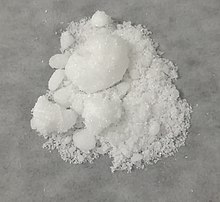 | |
 | |
| Names | |
|---|---|
| IUPAC name Cadmium(II) bromide | |
| Other names Cadmium dibromide | |
| Identifiers | |
| CAS Number |
|
| 3D model (JSmol) | |
| ChemSpider | |
| ECHA InfoCard | 100.029.241 |
| EC Number |
|
| PubChem CID | |
| RTECS number |
|
| UNII | |
| CompTox Dashboard (EPA) | |
InChI
| |
SMILES
| |
| Properties | |
| Chemical formula | CdBr2 |
| Molar mass | 272.22 g/mol |
| Appearance | white solid |
| Density | 5.192 g/cm, solid |
| Melting point | 568 °C (1,054 °F; 841 K) |
| Boiling point | 844 °C (1,551 °F; 1,117 K) |
| Solubility in water | 56.3 g/100 mL (0 °C) 98.8 g/100 mL (20 °C) 160 g/100 mL (100 °C) |
| Solubility | soluble in alcohol, ether, acetone and liquid ammonia. |
| Magnetic susceptibility (χ) | -87.3·10 cm/mol |
| Structure | |
| Crystal structure | Rhombohedral, hr9, SpaceGroup = R-3m, No. 166 |
| Hazards | |
| GHS labelling: | |
| Pictograms |  
|
| Signal word | Warning |
| Hazard statements | H302, H312, H332, H410 |
| Precautionary statements | P220, P273, P280, P501 |
| NFPA 704 (fire diamond) |
 |
| Lethal dose or concentration (LD, LC): | |
| LD50 (median dose) | 225 mg/kg, oral (rat) |
| NIOSH (US health exposure limits): | |
| PEL (Permissible) | TWA 0.005 mg/m (as Cd) |
| REL (Recommended) | Ca |
| IDLH (Immediate danger) | Ca |
| Related compounds | |
| Other anions | Cadmium chloride, Cadmium iodide |
| Other cations | Zinc bromide, Calcium bromide, Magnesium bromide |
| Except where otherwise noted, data are given for materials in their standard state (at 25 °C , 100 kPa).
| |
Cadmium bromide is the inorganic compound with the formula CdBr2. It is a white hygroscopic solid. It also can be obtained as a mono- and tetrahydrate. It has few applications.
Preparation and structure
Cadmium bromide is prepared by heating cadmium with bromine vapor. The tetrahydrate has been obtained by crystallization of the dibromide from aqueous solution. At 3.04 g/cm, it is much less dense than the anhydrous material. According to X-ray crystallography, the tetrahydrate is a polymer of CdBr2(H2O)2 with bridging bromide ligands. There are two interstitial water molecules
References
- ^ NIOSH Pocket Guide to Chemical Hazards. "#0087". National Institute for Occupational Safety and Health (NIOSH).
- ^ F. Wagenknecht; R. Juza (1963). "Cadmium bromide". In G. Brauer (ed.). Handbook of Preparative Inorganic Chemistry, 2nd Ed. Vol. 2. NY, NY: Academic Press. p. 1096.
- Leligny, H.; Monier, J. C. (1978). "Structure Cristalline de CdBr24H2O". Acta Crystallographica Section B. 34 (1): 5–8. Bibcode:1978AcCrB..34....5L. doi:10.1107/S0567740878002186.
| Cadmium compounds | |
|---|---|
| Cadmium(I) | |
| Cadmium(II) | |
| Bromine compounds | |
|---|---|
| Br(−I) | |
| Br(−I,I) | |
| Br(I) | |
| Br(II) | |
| Br(I,V) | |
| Br(III) | |
| Br(IV) | |
| Br(V) | |
| Br(VII) | |
This inorganic compound–related article is a stub. You can help Misplaced Pages by expanding it. |